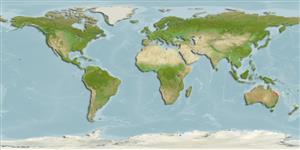>
Eupercaria/misc (Various families in series Eupercaria) >
Sparidae (Porgies)
Etymology: Acanthopagrus: Greek, akantha = thorn + Greek, pagros, a kind of fish (Ref. 45335).
More on author: Günther.
Environment: milieu / climate zone / depth range / distribution range
Sinh thái học
Biển; Thuộc về nước lợ gần đáy; Ở đại duơng, biển. Temperate; 19°S - 38°S
Southwest Pacific: endemic to eastern Australia, from Townsville in Queensland to the Gippsland Lakes in Victoria (Ref. 75154). Occurrence in Japan and Ryukyu Islands (Ref. 559) and Taiwan (Ref. 5193) need verification.
Length at first maturity / Bộ gần gũi / Khối lượng (Trọng lượng) / Age
Maturity: Lm ?, range 24 - ? cm
Max length : 66.0 cm SL con đực/không giới tính; (Ref. 44894); Khối lượng cực đại được công bố: 4.5 kg (Ref. 6390); Tuổi cực đại được báo cáo: 14 các năm (Ref. 56606)
Inhabitant estuaries, coastal rivers, creeks, lakes and bays, usually in marine or brackish water, but in dry seasons they penetrate the lowermost reaches of fresh water (Ref. 44894). Common in coastal and estuarine rocky habitat. They enter rivers upstream to the limit of brackish waters. They migrate from their feeding to their spawning grounds; they spawn mainly during winter in the vicinity of river entrances; eggs are planktonic and hatch after 2.5 days. A portion of the population changes sex from male to female after spawning. They feed on mollusks, crustaceans, worms, fish and ascidians. It is parasitised by the monogeneans Anoplodiscus australis and A. spari on the fins and body surface (Ref. 124057).
A proportion of the population change sex from male to female after their first spawning season (Ref. 6390). Other fish remain functional males throughout their life and another small proportion develop directly into females at the age of 4 years (Ref. 27246, 28262). Also Ref. 28504.
The eggs and larvae are planktonic (Ref. 30572). After about four weeks the developed fry enter the estuary at night on the full moon and settle in estuarine littoral areas at about 1.4 cm in length (Ref. 30572). The fry rapidly develop into juveniles and grow to about 10 cm after one year (Ref. 30572).
Kailola, P.J., M.J. Williams, P.C. Stewart, R.E. Reichelt, A. McNee and C. Grieve, 1993. Australian fisheries resources. Bureau of Resource Sciences, Canberra, Australia. 422 p. (Ref. 6390)
IUCN Red List Status (Ref. 130435: Version 2024-1)
Threat to humans
Harmless
Human uses
Các nghề cá: Tính thương mại; Nuôi trồng thủy sản: Tính thương mại; cá để chơi: đúng
Các công cụ
Special reports
Download XML
Các nguồn internet
Estimates based on models
Preferred temperature (Ref.
123201): 20.2 - 26.1, mean 24.7 °C (based on 68 cells).
Phylogenetic diversity index (Ref.
82804): PD
50 = 0.5000 [Uniqueness, from 0.5 = low to 2.0 = high].
Bayesian length-weight: a=0.01259 (0.00609 - 0.02604), b=3.03 (2.86 - 3.20), in cm total length, based on LWR estimates for this (Sub)family-body shape (Ref.
93245).
Mức dinh dưỡng (Ref.
69278): 3.1 ±0.40 se; based on food items.
Thích nghi nhanh (Ref.
120179): thấp, thời gian nhân đôi của chủng quần tối thiểu là 4.5 - 14 năm (tm=3-4; tmax=14; Fec=300,000).
Fishing Vulnerability (Ref.
59153): Moderate to high vulnerability (52 of 100).
Nutrients (Ref.
124155): Calcium = 35.9 [17.6, 68.9] mg/100g; Iron = 0.358 [0.201, 0.691] mg/100g; Protein = 19.4 [18.3, 20.5] %; Omega3 = 0.57 [0.34, 0.97] g/100g; Selenium = 10.5 [5.1, 20.6] μg/100g; VitaminA = 10.2 [3.0, 30.3] μg/100g; Zinc = 0.67 [0.47, 0.95] mg/100g (wet weight);
